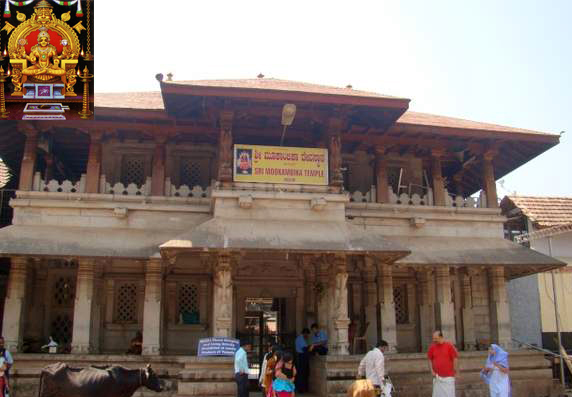Name of the Temple |
|
Location |
- Temple is situated at Kollūr village of Kundhāpūr tāluk in Uḍupi district of Karṇātaka.
|
| How to reach there? |
- By Air: Mangaḷūru International Airport is the nearest airport, 133 km. From the Mangaḷūru International Airport take the State Highway 66 north to reach Kollūr.
- By Train : The nearest railway station is Kundhāpur, 44 km south of Kollūr and Baindhūr railway station, 30 km west of Kollūr.
- By Road: Kollūr is connected by the National Highway 66 from Kanyākumari to Panvel.
|
|
Deity/Deities |
- Temple is dedicated to Goddess Mūkāmbikā.
- The main deity of this temple is the Śhivalinga which is called the Jyothirlingam. This linga is standing in front of the image of the Goddess Mūkāmbikā.
- Different sides of the lingam of the Kollūr Mūkāmbikā Temple represents different deities. The right side is said to be the representative of Brahmā, Viṣhṇu and Śhiva who are representatives of principles. The larger left side represents Lakṣhmi, Saraswathi and Pārvathi who provide creative energy to mankind.
|
|
Mythology |
- Long ago in third 'manwanthara' during the reign of Utthama Manu this place was known as Mahāraṇyapura. There existed nothing but dense forest. Once a sage named Kola Maharṣhi visited this place and saw a self manifested (swayambhu) lingam (phallus) here. Attracted by the beauty and serenity of the spot and also by the divinity of the phallus he decided to make Mahāraṇyapura his place for penance. Pleased at the devotion of Kola Maharṣhi, Lord Śhiva appeared before him and asked about his wishes to grant him boons. Kola Maharṣhi, who denounced all material comforts, had no wishes to fulfill. He requested Śhiva to make his place of worship a 'siddhi kṣhethra' (abode of mystic power) where people in distress could always look for solace. Lord Śhiva granted his wishes and told Kola Maharṣhi that in 'thāpasa manwanthara' Goddess Ādhiparāśhakthi would make this place her abode and subsequently this place would become a hallowed sanctuary. Lord Śhiva renamed this place as Kolapura in honor of Kola Maharṣhi. (Kollūru is the abbreviation of Kolapura).
- Kola Maharṣhi and other renowned sages made this place their 'thapobhūmi' (place of sacred rituals). After many years a demon king named Kamhāsura, came across this enchanting place and made it his capital. He started tormenting gods and sages. Then Lord Indhra requested Ādhiparāśhakthi to rid them of his troubles. Kamhāsura got wind of this and ran away to Riṣhyamūkāchala.
- Few years later Mahiṣhāsura a nephew of Kamhāsura came to Kolapura and decided to make this place his capital. He got Maya, the architect of demons to construct a beautiful city here. Invincible as he was, Mahiṣhāsura conquered the three worlds. Fearing his fury all Gods and sages went into hiding .Then they requested the trinity (thrimurthi) for help. Trinity invoked goddess Ādhiparāśhakthi to destroy Mahiṣhāsura. All gods including trinity merged their divine potency in Dhevi. Thus Dhevi became an entity exemplifying all forms of divine powers.
- In the fierce battle that ensued Ādhiparāśhakthi killed Mahiṣhāsura. After the annihilation of Mahiṣhāsura, Kola Maharṣhi requested Ādhiparāśhakthi and the trinity to stay at the self-manifested phallus at Kolapura as the embodiment of all powers. They readily agreed to this and Goddess Ādhiparāśhakthi occupied the left portion of the lingam where as trinity occupied the right portion. A golden line divides the Lingam into two unequal halves, the larger portion representing Lakṣhmi, Saraswathi and Kāli and the smaller portion representing Brahma, Viṣhṇu and Śhiva. Śhrīchakra was invoked into the lingam. Thus Kolapura became a holy place.
- Kamhāsura who had gone to Riṣhyamūkāchala did devoted penance invoking the blessings of Brahma to become invincible and conquer the world. Goddess Ādhiparāśhakthi could foresee his designs and she made him dumb (mūka). So when Brahma appeared before him, he could not ask for any boon. Thereafter he came to be called as Mūkāsura. Disappointed and deprived Kamhāsura became very furious and started destroying everything that befell his eyes. Then Devi killed him. Ādhiparāśhakthi who made Kamhāsura dumb came to be known as Mūkāmbikā .
- It is said that Ādhi Śhankara who is a great and renowned religious leader installed the metal image of the goddess behind the lingam. The unique thing of the Kollūr Mūkāmbikā Temple is that the lingam has been divided into unequal two parts by a golden line which becomes visible when the sunlight falls on them.
|
Rulers/builders and Time Period |
- The temple history begins with the arrival of sage Śhankarāchārya at this place in 8th century A.D.
- It is believed that Ādhi Śhankara perceived the idea of having a Mūkāmbikā Devi temple at Kollūr and himself installed the idol of deity in the temple some 1200 years ago.
- Historically it is believed that this place was inhabited by Śhākthas called Kaulas and that was how this place came to be called as Kollūr
- Honneyakambaḷi Kings of Hosaṅgaḍi have been ruling Kollūr and they were ardent devotees of Mūkāmbikā. Venkaṇṇa Sāvantha of this dynasty built the stone structure of the temple in 11th century A.D.
- Chieftains of Barkūr were also devotees of Mūkāmbikā and they created a lot of endowments for the temple.
- During the reign of King Virūpakṣha of Vijayanagar, Pandaridheva was his sāvantha at Barkūr and at his time Mūkāmbikā temple became very famous.
|
Other Special Features |
- Keḷadhi Venkatappa Nāyak ordained special pūjās and festivals at the temple and directed that his subjects should regularly worship Mūkāmbikā. Keḷadhi Vīrabhadhra Nāyaka had named his wife as Kollūr ammaji. These kings donated vast tracts of land to the temple and made arrangements for various festivals at the temple.
- The Maharājas of Mysore and Travancore were devotees of Mūkāmbikā and they had presented valuable gold ornaments to her.
- Jayachāmarajendhra Wodeyār of Mysore and Chitthirai Thirunāḷ Maharāja of Travancore had visited the temple.
- Thippu Sulthān of Mysore had visited this temple and a special 'maṅgaḷa ārathi ( Dīpārādhhana)' was conducted at his behest. That pūjā is being continued even today and it is called 'Salām Mangaḷārathi' which follows the main pūjā during night session.
- There are enough evidences in the forests surrounding Kollūr to indicate that once upon a time this was a well built place.
|
Any Other/Remarks |
- Mūkāmbikā Temple has a treasure of invaluable jewels. These were offerings made by various kings to the mother Goddess. A rare green stone of inestimable value gifted to the Goddess by Keḷadhi kings some 600 years.
- Gajamutthu (pachyderm pearl) which is a stone very rarely found in the skull of elephants, Navarathna necklace presented by the King of Mysore, ruby necklace presented by the king of Travancore, a large sovereign necklace are other important items.
- Goddess Mūkāmbikā Temple situated at the bottom of lush Koḍachādhri peak and the banks of the Sauparṇikā River offers beautiful sights and a very warm feeling for the devotees.
- Kollūr Mūkāmbikā Temple is one of the seven pilgrims created by Parashurama and is regarded as a very sacred place by the devotees.
|
Special Reference to Performing Arts |
- The story of Mūkāmbikā was scripted by Vedhavyāsa in his epic "SKANDHA PURĀṆA". It is narrated as a story told by Lord Śhiva to his son Skandha. A poet named Lingaṇṇa Kavi had written a book titled 'Keladhi Nrupa Vijaya' in 1750 A.D and this book contains a lot of references to Mūkāmbikā Temple.
- Muthuswāmi Dīkṣhithar, the revered Carnatic Music Composer has sung the glory of several temples all over India. His famous composition is ‘Mūkāmbikām Āśhraye Bhhāmathīm Sathīm’ – Dhanyāsi – Ādhi.
- The nine-day music festival begins every January at the temple.
- For the past 30 years Yesudhās has been coming to Kollūr Mūkāmbikā temple on his birthday to sing kīrthans of Saraswathi dhevi. The music festival was started from his 60th birthday. In 2010 January 10 he celebrated his 70th birthday at the temple with ‘Sangīthārchana’ (classical devotional songs), along with 70 singers before goddess Mūkāmbikā Mookambika on Sunday. The Sangīthārchana included ‘Pancharathna gāyana’ of Thyāgaraja’s songs. He also took part in the Vidyarambha function.
- Kānhangāḍ Rāmachandhran is a singer and musician from Kānhangāḍ, Keraḷa . He is better known as one of the disciples of legendary singer Padmabhushan Dr . K . J . Yesudhās . He is the first Indian in the mid 80s to hold the title for singing non-stop for 25 hours in the Guinness World Record. He has over 25,000 stage performances to his credit all over India and abroad. Ramchandran has performed in Mūkāmbikā Temple.
- The other famous songs played in the temple are:
- Mūkāmbikā Suprabhhātham Part -1
- Mūkāmbikā Suprabhhātham Part -2
- Mūkāmbikā Amme Jayajaya Dhevi
- Mūkāmbikā Ānandha Lahari
- Mūkāmbikai Bhagavathi
- Mūkāmbikā Abhaya Mudhrā
|
Bibliography |
|















